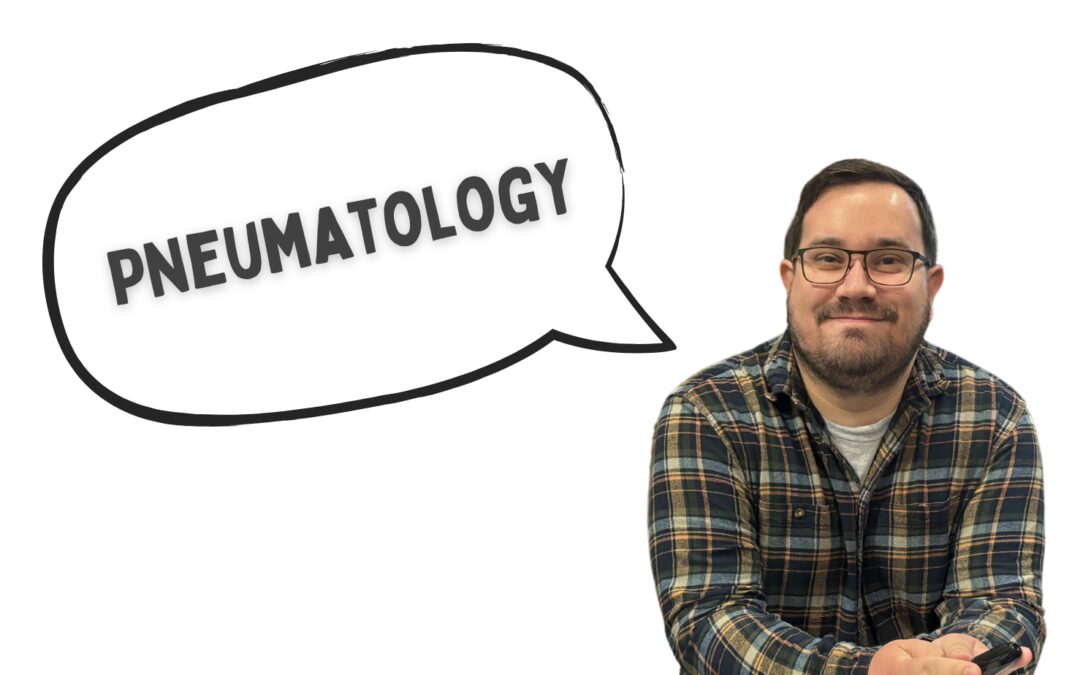Hello & Welcome! Today we’ll be discussing Pneumatology, otherwise known as, the theology of the Holy Spirit. I’ve been excited about this episode for a while now, since I feel I kinda underdeveloped Him in the trinity episode. If you’re new to the blog, here’s how it’s gonna go… first we’ll talk history, then notable figures, then key characteristics, and then conclude with some misconceptions. Let’s just dive right in!
History:
So it’s actually kinda funny that the history of the Holy Spirit is actually deeply intertwined with the other members of the trinity. And specific theological discourse about the Holy Spirit actually didn’t start until after the theology of the trinity, and the theology of Christ were fully developed. The first mentions of the Holy Spirit that Christianity has is the Hebrew word “Ruach” in the Old Testament; which really can’t be translated properly into English, but is most often translated “spirit”. Before the gospel writers officially gave Him His specific designation in the New Testament.
But just because He was now named did NOT mean that He was well known. The early Patristic period had no idea how to describe and define the Spirit. God the Father was easy because Genesis speaks of Him, the creator and provider. And Jesus is well defined since this was only one generation removed from Him, but the Spirit they asked “Where did he come from?” “What does he do?” Is he a medium for God the Father, or the empowerment of the Son? These were all questions that the early church asked. Only one figure emerges from this period with any kind of theological discussion on this topic.
Montanus who was active from 135-75 believed that the Holy Spirit was known for empowering the church in the modern day, such as giving dreams, visions, and prophetic revelations to those Christians who needed or wanted to see it. However, it is commonly assumed that Montanus was referring to himself as the Holy Spirit. Which is.. well, unfortunate.
It wasn’t until the fourth century that the Holy Spirit got considerable Theological discussion. Before this point, dear reader, frankly the theologians of the day felt that they had bigger fish to fry theologically! With the debates regarding the trinity and Jesus’ divinity taking more precedence, at the time.
Once discussion of the Holy Spirit began the first major debate was if the Holy Spirit was divine, meaning part of God, or if he was merely an expression of God. This debate however was ended by Athanasius, who pointed to the fact that since Jesus’ day Christians were baptized in the name of “the Father, The Son, and the Holy Spirit” meaning that at least in the disciples view, the Spirit was equal with both the Father and the Son; so He clearly should continue to be identified as a part of God. But even this argument couldn’t convince everyone especially because the Bible doesn’t outright say that the Holy Spirit is divine, so orthodox theologians were hesitant to say anything about the topic.
Now there was a debate knows as the Filoque controversy, which was specifically about the Holy Spirit’s relation to the other two members of the trinity. Namely, in the Nicene Creed it says the Holy Spirit proceeded from the Father, and that’s it, the Nicene Creed’s purpose being the unity of doctrine throughout the western and eastern branches of the church, which at this time were one. However, in the ninth century the western church added the phrase, “and from the son” to the creed, which is the Latin word Filoque, which became the name of the controversy. Now this was a problem for the east because for one it made the truth of the creed able to be added to, which they thought was wrong. But the big reason why this was an issue was because theologically speaking, if the Holy Spirit comes from the Father AND the Son, meaning they can both assign divinity, which challenges the Father’s role as the prime source of divinity and holiness that He then divides out, to them this bleeds the lines of the Father and as the Son too much. So a compromise was reached by saying that Jesus is begotten by God, while the Holy Spirit is breathed by God. Which basically means the Holy Spirit is the means by which man experiences God or as our Founding Pastors like to say the Holy Spirit is “Tangible God”.
This point was further developed by Augustine, who unfortunately was not able to fully bridge the gap between the East and Western theologies. However, he definitely supported the idea of the Holy Spirit coming from God the Father. After the great schism this distinction remains, however in the eleventh council of Toledo in 675 the western church specifically stated that they did NOT believe there were two sources of divinity but at this point the debate had long come and gone.
After this the theological development of the Holy Spirit kinda tampered off until actually fairly recently, the modern period or rather the period after 1900, saw an interesting development in the creation of Pentecostalism. This denomination specifically focuses on the manifestations of the Holy Spirit as seen at Pentecost. Most scholars believe that Pentecostalism began at Bethel Bible College in Topeka Kansas, by Charles Fox Parham who had roots in Methodism. Up to this point the denominate view of the Holy Spirit and His actions on the earth were Cessationism or the idea that the gifts given to the disciples ended there.
So the story goes that Parham asked his students to go and find manifestations or actions of the Holy Spirit in the world, as he and his students started to look they began to notice within the Holiness tradition that several people appeared to be speaking in other tongues, like the book of Acts. This startled and surprised Parham, who began to tell others that maybe the gift of tongues wasn’t so gone after all. One of the people he spoke to about this was William J. Seymour, pastor and founder of the Apostolic Faith Mission on Asuza street in Los Angeles in April of 1906 and everyone knows about them.
For those who don’t though Azusa Street was the place of a major revival of the gifts of the Holy Spirit, speaking in tongues, supernatural healings, and many other signs manifested there. For there Pentecostalism exploded growing into a world wide expansion of Christianity, leading to the creation of Evangelicanism, liberation theology, and much more.
Pentecostalism is still going strong today, with such churches as Bethel in Redding, CA and Elevation Church both showing manifestations of the Spirit.
Notable Figures:
Augustine:
So Augustine can really be said to have developed a good chunk of the theology of the spirit, and most of what is considered orthodoxy today is due to his pursuits. While he neglected to bridge the gap to the east, his breath of information demands he be mentioned here. One big element that Augustine saw about the Holy Spirit was that he was the bound of unity between believers and the Godhead. That the Father creates you, Jesus saves you, and the Holy Spirit keeps you that way. Also, among his contributions is that the Holy Spirit is the expression of divine love of the Father, His constant presence and actions proving that; kinda like a good husband who’s always there when you need him.
Jonathan Edwards:
Once again Jonathan Edwards ends up in our honorable mentions: I really love this guy! He had some cool thoughts about the Holy Spirit. So Edwards agreed with Augustine that the Holy Spirit is a element of unity, however he took it one step further and said that the Holy Spirit united man and God, both literally and spiritually AND in the person of Christ. Edwards believed that the Holy Spirit was able to create and did create the Hypostatic union, which means he kept Jesus in perfect balance with His spiritual and physical selves. Which is a fascinating thought.
William J. Seymour:
So Seymour needed to be mentioned here, because while Parham saw things starting he didn’t lean into it, while Seymour on the other hand, did. He saw something God did and decided to give it all he had. I think Seymour’s faith is what allowed Azusa to be so big, and I think his idea of the modern Christian having the same power as those in the book of Acts, and that the Holy Spirit was for everyone not just the privileged few really was revolutionary, and a good chunk of Christianity today shares this idea.
Key Characteristics:
Presence:
The Holy Spirit has a huge characteristic of being present. That He is present in the world today and present with us in every situation; this comes from Scripture and outside sources as well. This is a major theme of the Holy Spirit, this idea that He is always here and always present both good and bad. Some theologies have presented the idea of the Holy Spirit being present as bad because God “sees everything you do” while others present it as good “the Lord is here no matter what.”
Symbology:
The Holy Spirit, due to being not well known and not well characterized, is often presented as being like something or comparable to something to of fire and wind (the two most predominant modern symbols). Symbology takes on an extra level of importance with the Holy Spirit, I think this is due to the Holy Spirit never being physically described, while the Father is described in many aspects in the Old Testament, and Jesus is physically seen interacting with people in the New Testament, the Holy Spirit is never fully described. So symbols are the only way people can really describe Him. He comes and goes and is mysterious like the wind, and he burns away our sins like fire.
Regeneration:
Last and most importantly, the Holy Spirit’s most important characteristic, is His role in salvation. So pretty much everyone of our notable figures have added elements to this, but to make it simple, the Holy Spirit regenerates us, completely changing our nature and keeping us from sin.
Misconceptions:
That the Holy Spirit is just a feeling:
Many critics of the charismatic movement and of pentecostalism stem from the fact that for a large portion of Christianity’s history the ideas of “the gifts of the Spirit” or “moves of the Holy Spirit” were seldom seen and even more seldom believed. Many critics of today have lost the undergirding of theology by giving in to “feelings” or “feel Good” doctrines. Which is super unfortunate.
That the Holy Spirit came from God, and is not part of God:
So this was actually a big debate in the early church, about where exactly the Holy Spirit came from and what exactly his nature and personhood are.
That He is not active in the world today:
This is kinda connected to the first point, that many believe that the Holy Spirit was only given to the Apostles, and then disappeared. However, this generally doesn’t explain people such as John Lake, Smith Wigglesworth, and other such people who did things that only supernaturally empowered men/women have done, such as heal and the working of miracles. This is typically explained away as falsehoods, but this is dangerous because of expressions of the Holy Spirit in the somewhat modern day are false, who’s to say that it wasn’t false in the Apostles day?
That’s all I have for you today.. thanks for reading! Go in peace!


Recent Comments